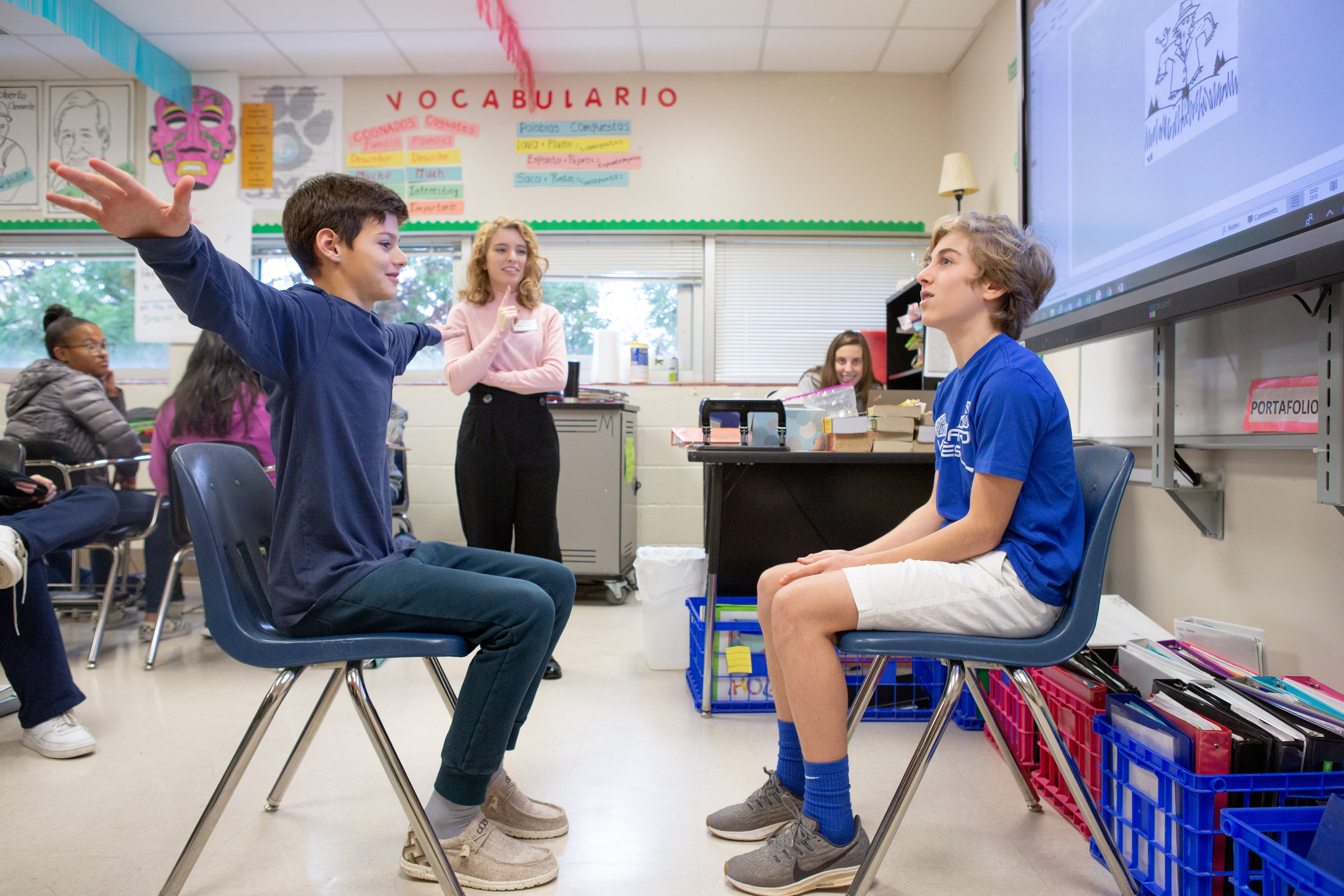Total Physical Response

Total Physical Response (TPR) connects vocabulary and phrases to actions or gestures. Teachers can also use actual signs from American Sign Language to provide culturally responsive gestures. This strategy is part of Colorin Colorado's ELL Strategy Library and can be used to support academic language development for all students.
Strategy Overview
How This Strategy Supports Language Development
When using TPR, teachers model an action for each new vocabulary or phrase or ask students to create an appropriate gesture for key terms and phrases. Then, students respond to commands using that word or phrase by doing the action or gesture.
TPR is a language teaching method developed by James Asher in the 1960s that is based on the way babies learn their first languages. Because students are not required to speak to demonstrate comprehension, the method lowers their stress. And since students’ receptive skills (listening and reading) generally precede their productive skills (speaking and writing), TPR gives them a way to demonstrate comprehension and participate fully with grade-level content. When students use a hand or body gesture to symbolize a key term, they often learn the terms more quickly and retain them for longer.
TPR can be used in any content area at any grade or age level to increase comprehension and retention of key vocabulary and phrases.
Step-by-Step Instructions
- Select essential vocabulary words and phrases for the unit of study.
- Determine an appropriate gesture for each word or phrase. Review each concept for the possibility of adding a gesture or ASL sign to the word when teaching and practicing this concept in class. Use handspeak.com to find ASL gestures for many words and phrases.
- Introduce the new word or concept in context with the gesture (and/or a prop, image, or manipulative). Write the word or phrase on the board.
- Ask students to repeat the gesture in the context of a command such as, "Hold up the picture of the __;" "Show me __;" "Point to the ___."
- Introduce the next word or phrase in context of the unit with a gesture (and/or a prop, image, or manipulative).
- Practice both new words and phrases with commands. Mix and match the 2 words and phrases using commands such as, "Put the picture of the ___ on top of the ___." "Show me ___ and ___."
- Continue introducing up to 7 new vocabulary and phrases with gestures. Practice all of these new words and phrases in the context of total physical response commands.
- Ask students to practice the concepts with gestures with a partner. One partner says the key term and the other partner does the appropriate gesture and explains in complete sentences what the term means. In this way, students will link the term to the gesture and the meaning.
- Use gestures as a quick formative assessment tool. Simply ask the class to, "Show me the gesture for ____." Look around the room at the responses to gauge comprehension.
Lessons Learned
- Not all words or concepts need a gesture or ASL sign attached. Some are better learned through a video, picture, or realia. See the examples above.
- Be careful to establish comprehensible input for any gesture that is representative of a concept. While many verbs and some adjectives can be easily acted out or gestured, some gestures can be misconstrued, if the word is not clearly explained first. For example, standing up from a chair as a gesture for "stand up" is unlikely to be confused with another concept. However, touching your head for the "heading" of a text could be misinterpreted as "head" rather than "heading."
- Students may quickly learn gestures associated with words, but not actually understand the meaning of the word. Continually check on comprehension of gestures that are symbolic for abstract concepts.
- Start practice sessions by having the entire class gesture or demonstrate the response to the command. Divide students into small groups for demonstration purposes later in the lesson.
- Stop modeling after a few repetitions, so you can gauge students' comprehension, not their ability to follow you.
- Partners and small groups can practice commands with each other after they have practiced in the whole group. One student will need the list of commands to give their small group: "Show me an acute angle." "Show me precipitation." "Point to the picture of the telescope."
- When possible, use ASL gestures for vocabulary so you teach both ASL and a meaningful gesture for the words.
- Include manipulatives, pictures, or props for some words.
- Teach collocations and phrasal verbs as one phrase rather than as individual words ("pick up," "drop off," "open your book").
- Include commands for any physical demonstration of comprehension including: "show me," "point to," "draw," "look at," "walk to," "hold up," "take out," etc.).
- Invite students to help create gestures for keywords once they understand the process.
- When students are watching each other to do the gestures, they are still learning. However, if you want to quickly assess which students know the gesture for a word, you can ask students to close their eyes for a minute while you say the terms.
- TPR works in any content area. Students can gesture everything from content-specific terms like "parabola" to general academic terms like "identify" and "compare."
- Do not require students to make any gesture. Gestures support learning and help with retention, but students do not personally have to do each gesture in order to benefit from watching others do the action.
Differentiation
Entering/Emerging
- This method was developed for entering and emerging level students. If teachers use TPR for abstract terms (e.g. "metaphor," "justify," "therefore"), they should probably translate those terms for entering/emerging students as the gesture may not be comprehensible without it.
- Students at entering levels of language development can simply show the gesture for key concept words instead of explaining what they mean. They can explain their understanding of the concept and gesture in their heritage language.
Developing
- Students at this level can identify new words and phrases in texts and create their own gestures for them to help them remember the terms.
Expanding
Give students the opportunity to give the commands to the whole class using the key vocabulary. Other students in the class can respond to the command by doing the gesture.
Examples
| Content | Question Focus | Sample Student Questions |
|---|---|---|
| Pre-school |  |
|
| Science: Elementary |  |
|
| Middle School: Language Arts |  |
|
Co-Teaching Considerations
Content or Grade-Level Teacher
1. Choose the essential content vocabulary or concepts.
2. Determine a logical sequence for introducing the terms so they are connected and in context.
English Language Development Teacher
1. Translate abstract terms for entering/emerging level students.
2. Give TPR commands to a small group of entering/emerging level students to ensure comprehension of the terms.
3. Ask comprehension questions in heritage language as an additional comprehension check.
Resources
References
- ColorinColorado Glossary: TPR
- Learning Key Phrases through TPR (ColorinColorado)
- Learning Another Language Through Actions by James Asher
- The Teacher Toolkit TPR


